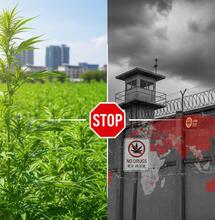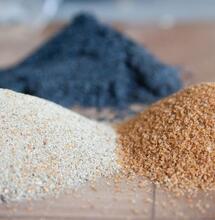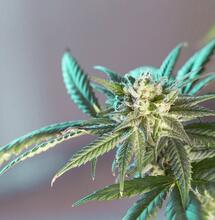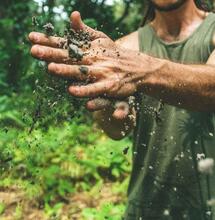How Do You Heal Your Dying Cannabis Plant?
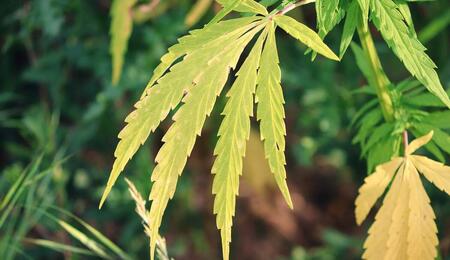
Growing cannabis can sometimes be so easy that you won't even notice you are in the process of growing your own. Then, there are those times when things go wrong and you must take extra measures for your crop to succeed. The first and most important thing to do when you realize that something is off with your cannabis plant is to identify what's causing the issue. Is it a watering problem? Is it the nutrients? The growing medium? Grow lights too close? Once you figure this out, you can prepare a strategy to help heal and recover your plant.
Grow problems are a normal part of every grower's journey. As with any other situation in life, the important thing is to stay calm and find out what you can do to heal your marijuana plant. There could be many signs and symptoms of something wrong: yellowing, curling leaves, stunted growth, underdeveloped buds, pests, etc. For each scenario, there is something to be done to remedy the issue before it's too late.
General guidelines
- It's important to catch symptoms early. For example, if you notice that some leaves start to change their color, there are several quick checks that you can do to figure out the cause of colorations.
- It's important to follow how fast the condition is developing. Has there been a significant change in the plant's appearance over the last 24-48 hours, or is it something that has advanced through a couple of weeks now?
- Using a calendar or growing diary to track progress through the growing process can be helpful. For example, when did you add nutrients, how often do you water, when do you change room temperature and humidity, etc. Circle those days and write down details.
- Taking protective measures is sometimes the only way to prevent your plant from dying. For example, routine inspections for pests can prevent severe irreversible infestations.
Diagnoses and Treatment Strategies
A sickly cannabis plant can manifest various symptoms. Below we discuss the most common signs you should pay attention to and what steps you should take to help out your stressed or ill-looking plant.
Leaves Are Turning Yellow
The most obvious symptom that something is wrong with your cannabis plant is yellowing leaves. There could be several reasons why, but you primarily have to check on the water intake and nutrient intake.
Watering
Overwatering is one of the most common mistakes in growing cannabis. Excess water may weaken the plant. Vice versa, underwatering will also negatively affect the plant. In general, cannabis plants tolerate less water when they are young and can absorb more water while in the vegetative stage.
Symptoms to watch out for here? Yellowing or brownish leaves, wilting leaves, crispy, dry leaves, or bone dry soil.
Perform simple soil checks to see if your plant receives sufficient water. Place the tip of your finger slightly into the soil to see whether it appears to be moist, dry, or bone-dry. This will give you an idea of how much water there is at the surface level. Measuring the plant's weight is also helpful. Check the weight at different times: after watering, a day after you water, two days later, etc.
Whether you're using soil, rockwool, or coco coir may also affect the plant's water intake, drainage, and retention. Because of this, it's also good to measure pH and E.C. (electrical conductivity), which is very easy to do with digital pens. E.C. levels must not be too low or too high.
When the growing medium is drenched in water, it will usually dry out in 2-3 days. If it takes more days to dry out, the issue is probably overwatering, or the growing medium doesn't have good drainage and likely needs to lose it up a little bit. When the grow container dries out too quickly, the issue is insufficient water.
Solutions
Of the two issues, overwatering is a bit more challenging to handle.
- Start by draining the excess water to the best of your abilities.
- Keep the containers slightly lifted from the ground or place them on a layer of gravel or clay pebbles. This is to ensure that your plant does not sit in a saucer filled with pooling water.
- As excess water may cause valuable nutrients to wash away, consider boosting nutrients once you balance the water intake.
With underwatered plants, it's obvious what needs to be done: feed the thirsty monster with more water!
- Start by filling in the entire growing medium with water and allow about a quarter of the water to drain out.
- Repeat the finger test to the soil to determine when to water again.
- Installing a drip irrigation system can be helpful when you don't have the time to water your plants regularly.
- If your plants continue to struggle with underwatering, check out the containers. If your plants are too big (mature) and the containers are too small, you probably need to transplant to a larger size container.

Nutrients
Strange colorations or curling leaves in cannabis can also be attributed to nutrient issues, most notably Nitrogen Deficiency and Nitrogen Burnout (overfeeding). Nitrogen is a crucial macronutrient, the N in the N-P-K formula. Without it, plants won't be able to conduct photosynthesis, i.e., convert light energy into chemical energy. And if you don't fix this issue, your plant is going to die.
Most N-P-K nourish solutions are readily available, and they have instructions on the package on how much should be used. However, one recommendation is to dispense slightly less of the amount of nutrients it says on the package. Also, it is important to know that cannabis plants require a different balance of macronutrients depending on the stage of growth. The optimal feed may further depend on the strain of cannabis, which is where it might get complicated.
The general rule is that cannabis needs more significant amounts of Nitrogen during the vegetative phase and higher amounts of Phosphorus and Potassium during the flowering stage. Nitrogen stimulates leafy green growth, and Phosphorus and Potassium nourish the fruits.
Nutrient deficiencies can occur even when you follow all instructions correctly. Cannabis plants may suffer from a nutrient lockout, which means the soil pH is either too acidic or too alkaline. This results in blockage in the roots where the plant cannot absorb foods properly.
A nutrient issue can also present as nutrient burn. Such as when too many nutrients are dispensed in the soil, creating a toxic effect on the plant. Unrotten compost can also lead to nutrient burn. Dark-green leaves with yellow and brown tips are indicative of this diagnosis. There could also be reddish or purple stalks and branches, and calyx tips may start to die.
Solutions
Whether dealing with deficiency or lockout, you again need to use the pH pen and test a soil sample. For soil, the correct values should be between 6.0 and 6.5. Anything beyond these numbers may indicate a nutrient intake disbalance.
For nutrient deficiency, it's obvious that you need to boost the feed. Add gradually and observe how the plant reacts. Grow boosters can help, too.
For a nutrient burn, you want to flush the soil immediately with pH-balanced water. Then, give the plant time to use the excess nutrients before adding more of the feed solution. Here's a guide on how to flush cannabis plants and the benefits of flushing.
Stunted Growth
Several factors can play a role in stunted growth. Plants can stop growing because of nutrient deficiencies, lack of light, or excess stress among others.
Nutrient deficiencies:
- Use a grow booster solution (lots of nice products are available to purchase online).
- Combine the grow booster with organic mycorrhizal fungi supplement as a root drench to help optimize the absorption rate of the plant's root system.
- Note that some nutrient deficiencies will require a different fix. For example, stunted growth due to Calcium deficiency is seen in the discolored young shoots and curled new growth. In this case, apply Cal-Mag plant supplement as instructed on the package.
Lights:
- Introduce a cycle of 18 hours vs. 6 hours off when plants are in the vegetative stage. Prevent any light cycle interruptions.
- Optimize the lighting if you are growing indoors. Check out these 7 quick tips for lighting.
Stress:
- Avoid transplanting the plant multiple times. Transplanting a seedling directly into a final, spatially satisfactory container is the best way to go.
- In general, avoid any extremes in the growing environment. Stress can happen due to too high or too low temperatures, excess levels of humidity, light interruptions, etc.
Here's how to ensure that you amend temperature and humidity ranges correctly during each stage of growth:
Seedlings:
- Humidity range: 65-70%. High humidity levels will ensure that your seedlings can absorb water through their leaves.
- Temperature: 68-75°F. Reduce the temperature by 5-7 degrees when lights are off.
Vegetative stage:
- Start to lower the humidity level by 5% each week. The lowest in the range you can go is 40%. The vegetative stage means the plant sufficiently consumes water through its roots and uses the leaves for evaporation and cooling.
- Temperature: 70-80°F. Reduce the temperature by 5-7 degrees when lights are off.
Flowering stage:
- Humidity range: between 40 and 50%.
- Temperatures: 67-75°F.
Before Harvest:
- Drop humidity in the 30 - 40% range two weeks before harvest time.
- Temperatures: 65-74°F. Reduce the temperature by 5-10 degrees when lights are off.

Stretching
"Stretching" is the rapid growth of cannabis stems. This is a natural part of the vegetative stage and can be determined by genetic and environmental factors, among others. However, stretching can sometimes cause cannabis plants to become structurally weak, and the risk of toppling over with that.
A quick fix is repositioning the lights if your seedlings are becoming "leggy" or the stems elongate too much during vegetation. There is a great chance that due to lack of light exposure, the plant tries to reach closer to the nearest source of light.
Excess heat can as well contribute to lanky seedlings. So, it's important to stick to the recommended temperature ranges for each growth stage, as outlined above. Fans and air conditioning units can significantly help regulate the temperature.
Most weed plants experience a "flowering stretch" once they enter blooming. They gain extra size, and this may increase the risk of toppling over if the plant is leggy during vegetation. Support structures can help avoid a fiasco like that.
Underdeveloped Buds
Another red alarm is when weed plants produce poor flowers. Underdeveloped or "popcorn buds" as it's also called, is when the buds appear small, airy and flimsy. How to help them?
- Defoliate. Buds should not be hidden under a veil of a dense canopy. They need exposure to light and air to grow properly.
- Don't forget to increase on Phosphorus and Potassium once the vegetation phase is through.
- Pest control. Some bugs like to feed on flowers. A critter such as a budworm can quickly hollow out the plant fruit.
On a side note, perform pest control routinely as there are different types of bugs out there that may be after various parts of your plant and can cause great harm and damage. See tips here on how to deal with five of the most common cannabis pests.
Happy growing and try not to kill your plant!





